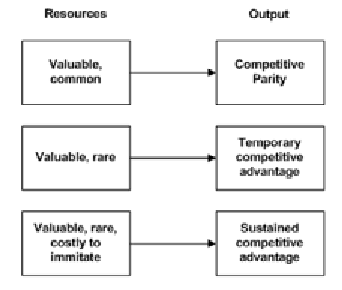Environmental Engineering Reference
In-Depth Information
Figure 1. Barney (1991)'s Resource-based view
of the firm
ing buyers are willing to purchase the resources'
outputs at prices significantly above their price;
(2) rare, such that the buyers cannot turn to com-
petitors for the same or substitute resources; and
(3) imperfectly imitable, such that it is difficult for
a competitor to imitate or purchase the resource
(Barney, 1991). Resources that are rare, difficult
to imitate, and valuable in a given industry are
referred to as “strategic resources” (Chi, 1994).
Internal resources can be divided into four catego-
ries: physical, human, social, and organizational
capital resources (Lucas, 2009). Physical capital
includes the technological artifacts utilized in a
firm, a firm's plant and equipment, and the firm's
geographic location (Barney 1991), whereas hu-
man capital encompasses individual employee's
knowledge, skills, and abilities. Social capital
refers to the knowledge embedded in groups and
networks of people; and organizational capital
includes institutionalized knowledge and codified
experience stored in databases, routines, patents,
manuals, structures and so forth (Lucas, 2009).
Capabilities are also identified as repeatable,
rule-guided patterns of action in the use of assets
to create, manufacture, and provide products or
services to a market (Sanchez
et al
., 1996). Capa-
bilities adapt, integrate, and reconfigure internal
and external organizational skills to match the
requirements of a changing environment (Teece
et al
., 1997). Helfat and Peteraf (2003) divided
capabilities into two categories: operational and
dynamic. Operational capability is defined as a
high-level routine that, together with its imple-
menting input flows, confers upon the management
of an organization a set of decision options for the
production of significant outputs of a particular
type, whereas dynamic capabilities construct,
integrate, or reconfigure operational capabilities.
According to Barney (1991), resources that
are valuable but common can only function as
sources of competitive parity; resources that are
valuable and rare can serve as sources of tempo-
rary competitive advantage; and resources that
are potential sources of sustainable competitive
advantage (Barney 1991). Valuable resources can
be utilized to exploit opportunities and or neutral-
ize threats in a firm's environment. Rare resources
are those that are limited in supply and are not
equally distributed across a firm's current and
potential competition. Inimitability refers to the
extent to which resources are difficult to replicate
by other firms. Inimitability may be the conse-
quence of a variety of factors, including social,
multicausal, or specific historical circumstances.
“Non-substitutability” means that a resource can-
not be simply replaced (or substituted) with another
one. Thus, if a firm possesses valuable, rare, and
sufficiently inimitable IT resources, the applica-
tion of IT resources to information processes in
a firm can generate competitive advantage, even
when no other sources are involved in the process
(Jeffers
et al
. 2008).
One of the primary critiques of Barney's (1991)
RBV theory is the static nature of the ingredients
required for competitive advantage. Mahoney and
Pandain have addressed this ambiguity by arguing
that a firm may achieve rents not only because it
has better resources, but rather because of the
firm's competence in making better use of its
resources (Mahoney and Pandain, 1992; Newbert,
2007). Resources also must be exploited for their
latent value, including core capabilities, compe-

